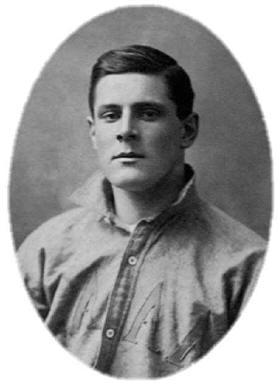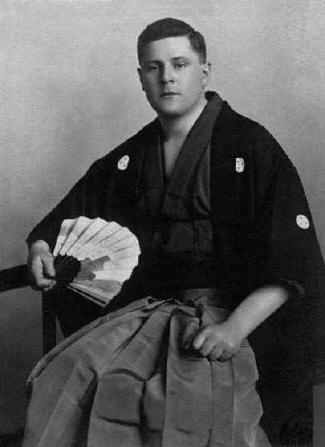|
 Up
until recently, I was able to discover precious little information about
the few lighting outfits in my collection that were sold under the
Messervey brand name. Then, on Christmas Eve, 2002, I was contacted by Ken
and Dennis Benson. John Herbert Messervey, owner and operator of Messervey
Industries, was their mother's uncle! Family historian Ken has kindly
agreed to provide me with as much information as possible. His efforts,
combined with my own research information, now make it possible to present
this interesting history of another early pioneer in the American and
Canadian Christmas lighting industry. Up
until recently, I was able to discover precious little information about
the few lighting outfits in my collection that were sold under the
Messervey brand name. Then, on Christmas Eve, 2002, I was contacted by Ken
and Dennis Benson. John Herbert Messervey, owner and operator of Messervey
Industries, was their mother's uncle! Family historian Ken has kindly
agreed to provide me with as much information as possible. His efforts,
combined with my own research information, now make it possible to present
this interesting history of another early pioneer in the American and
Canadian Christmas lighting industry.

1907 picture of John
Herbert "Bert" Messervey
taken in his
baseball uniform. He was 20 years old.
 John Herbert "Burt" Messervey was born in
Halifax, Nova Scotia in 1887. In his early years, he
played semi-professional baseball in the United States. As an adult, his
business was importing, and his company, Messervey Industries, offered a
wide variety of gift type items collected from the around the world. Among
his offerings were fans, pottery and parasols from the Orient, and silverware from
Persia (now Iran). He was quite prosperous, and knew both how to purchase
in a cost effective manner and market his wares effectively. He was
described by his niece as "tall, over six feet, and he had been quite an
athletic ballplayer when he was a teen. He came to visit us in the 1920s
when we lived in Toronto, and he lived in Buffalo, New York. My father
always talked about him like he was a hero. Uncle Burt was very lively."
It seems that Bert easily earned respect from both friends and family, in
part due to his imposing physical stature, but more due to his friendly
and outgoing personality. He was well liked, and quite prosperous. Below
are a few pictures of the types of goods that Bert Messervey imported in
the late teens and early 1920s: John Herbert "Burt" Messervey was born in
Halifax, Nova Scotia in 1887. In his early years, he
played semi-professional baseball in the United States. As an adult, his
business was importing, and his company, Messervey Industries, offered a
wide variety of gift type items collected from the around the world. Among
his offerings were fans, pottery and parasols from the Orient, and silverware from
Persia (now Iran). He was quite prosperous, and knew both how to purchase
in a cost effective manner and market his wares effectively. He was
described by his niece as "tall, over six feet, and he had been quite an
athletic ballplayer when he was a teen. He came to visit us in the 1920s
when we lived in Toronto, and he lived in Buffalo, New York. My father
always talked about him like he was a hero. Uncle Burt was very lively."
It seems that Bert easily earned respect from both friends and family, in
part due to his imposing physical stature, but more due to his friendly
and outgoing personality. He was well liked, and quite prosperous. Below
are a few pictures of the types of goods that Bert Messervey imported in
the late teens and early 1920s:
 |
 |
 |
 |
|
Examples of 1920s Japanese
Imports |
Bert on a buying trip in Japan, 1922
By 1918, Bert had offices in both Buffalo,
New York and Bridgeburg, Ontario. He ran his importing business out of
Buffalo, and his Christmas lighting concern out of an old church building
in Bridgeburg. He lived in Buffalo with his wife, Lillian Oakes Messervey.
While he was born in Canada, it is unknown in which country he claimed
citizenship, as over the years he addresses in both countries.
In the early days of Christmas lighting, the
major decorative lighting companies such as Propp, the Triangle Electro
Trading Company and others traditionally manufactured the lighting
festoons themselves. The companies mainly purchased their lamps from
General Electric, while a smaller number purchased from Westinghouse. It
was extremely uncommon for lighting outfits offered in the 1920s to have
lamps other than those from these two major companies, or, in the late
20s, from Japan as well. Bert Messervey's Christmas lighting sets,
however, were a bit different in that his outfits contained lamps made in
Japan but marked with his company's trademark name of "Buffalo".
 |
 |
Outside of typical
Messervey's
Christmas lighting outfit,
circa 1922 |
An inside view of the set,
showing the tungsten filament
pine cone shaped lamps |
Bert offered two different filament types;
carbon and tungsten. While the tungsten lamps were superior electrically,
they were more expensive to make and appealed to the more affluent of his
customers. The carbon lamps were less costly while still being quite
functional, and Bert sold both types of lamps in order to appeal to as
many customers as possible. His efforts were quite successful, and the
collector today can find examples of many of the lamps that Bert Messervey
sold.
Bert most likely purchased most of his
lighting strings from the Morris Propp Company of New York, as the vast
majority of Messervey branded outfits I have seen have the distinctive
Propp cloth covering of green cotton with interwoven red "polka dots", and
the easily recognized green composition sockets with the smooth, rounded
shape. The Messervey lamps contained in the sets are all marked "Buffalo",
which, as mentioned before, was a trademark of Messervey Industries and
not an indication of the place of manufacture.
Bert's Buffalo brand of figural lamps appear
to be almost identical to those sold at the same time by other companies
using lamps made in Japan. Since Bert's major business was importing, he
had the buying power to offer his Buffalo trademarked lamps in different
color combinations than what competing companies offered. While Messervey
carbon lamps used 100% Japanese technology, his tungsten filament lamps
used technology patented by General Electric. Illustrating this is the
fact that one of the Messervey tungsten filament lighting outfits in my
collection has the following statement, printed in small letters on the
inner flap of the box: "The Buffalo lamps contained in this set are sold
under a license extended to us by the Canadian General Electric Company,
Limited." This license refers to base, filament support and filament
components only, and not the glass shells. Since GE was the industry
leader in the manufacture of all light bulbs at the time, they were also
the patent holder for many of the procedures and components necessary to
manufacture effective light bulbs. Even Westinghouse, the second largest
maker of light bulbs, had to license many patent rights from GE's
holdings.
 |
 |
|
This 1922 figural light set
from Messervey Industries has lamps with the brass collars stamped
"Buffalo". |
The lamps sold by Messervey
Industries were all of the figural variety, and included popular shapes of
the time such as clowns, Santa Claus, snowmen and various fruits. Most of
these figural shapes had the less expensive carbon filaments in them, but
the glass envelopes had quality paint jobs in bright colors. Burt's
tungsten filament offerings were painted and colored glass seed pod or
pine cone shaped lamps, which burned more evenly from light to light and a
bit brighter than did the carbons.
Most likely in an effort to
save on production costs, the boxes that Bert sold his lighting outfits in
were a bit on the plain side when compared to the very brightly colored
examples from his competitors.
I have seen only two different
varieties of Messervey boxes. As pictured below, one has a Christmassy
indoor scene and the other an outdoor view:


The boxes were printed by an
independent jobber, and not in the Messervey factories. After the
Messervey company went out of business, other decorative lighting
companies employed the same artwork on their boxes, which was a common
practice in the industry. It is because of this fact that it is unwise to
assume a specific manufacturer of a lighting outfit based solely on the
box art and graphics.
Bert manufactured Christmas
lights at his factory in Ontario from about 1922 until March 20, 1931.
That Friday, Bert tragically lost his life in a fire at his Bridgeburg
factory. According to his obituary, Bert was working at 9:30 PM when an
explosion caused by spontaneous combustion started a fire. As he attempted
to put the fire out, his clothing ignited, severely burning his face,
hands and body. tragically lost his life in a fire at his Bridgeburg
factory. According to his obituary, Bert was working at 9:30 PM when an
explosion caused by spontaneous combustion started a fire. As he attempted
to put the fire out, his clothing ignited, severely burning his face,
hands and body.
He was able to extinguish his
clothing, and drove himself to Millard Fillmore hospital across the
American border in Buffalo. Canadian Customs Officials, horrified by
Bert's condition, called their American counterparts on the other side of
the bridge to wave Bert through as he passed. When he arrived at the
hospital, he collapsed, and passed away shortly thereafter. Although the
obituary states that Burt was 40, his actual age at the time of his death
was 43.
It was truly a sad ending for a
man so well respected and loved by his family and the communities in which
he worked. Bert had employed many family members in his businesses, and
after his death, Messervey Industries was no more, as the family made the
decision not to rebuild and carry on the business.
Many of the details of Bert and
his life have now faded into history. Bridgeburg, the little town in
Ontario across the river from Buffalo, New York, was renamed Fort Erie in
1932. It is interesting to note that along with some of Canada's earliest
electric Christmas lights, Bridgeburg was also host to the first Canadian
Jell-O factory.
I would like to personally
thank Ken and Dennis Benson for their help with this section of the site.
It is through kind efforts like theirs that this website continues to
grow, and is able to present interesting pieces of early electric
Christmas lighting history.
HOME
TABLE OF CONTENTS
|
































